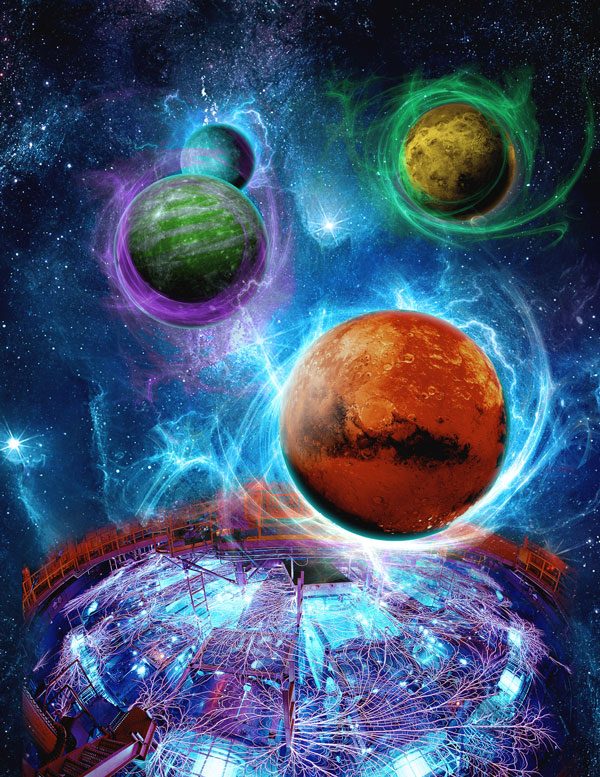A step in the search for other life in the galaxy
Researchers are using the huge forces generated by Sandia’s Z machine to replicate the gravitational pressures on so-called “super-Earths” to determine which might maintain atmospheres that could support life.

Astronomers believe that millions of super-Earths — collections of rocks up to eight times larger than Earth — exist in our galaxy.
“The question before us is whether any of these superplanets are actually earthlike, with active geological processes, atmospheres and magnetic fields,” said Sandia physicist Joshua Townsend.
The current work at Z is described in the Feb. 9 issue of Nature Communications. Researchers in Sandia’s Fundamental Science Program, working with colleagues at the Carnegie Institution for Science in Washington, D.C., used the forces available at Sandia’s uniquely powerful Z machine to apply the equivalent of huge gravitational pressures to bridgmanite, also known as magnesium-silicate, the most abundant material in solid planets.
The experiments gave birth to a data-supported table that shows when the superplanet’s interior would be solid, liquid or gaseous under various pressures, temperatures and densities, and in what predicted time spans. Only a liquid core — with its metals shifting over each other in conditions resembling those in an earthly dynamo — produces the magnetic fields that can shunt destructive solar winds and cosmic rays away from a planet’s atmosphere, potentially allowing life to survive.
Planetary cores revealed
Such critical information about magnetic field strengths generated by the core states of different-sized super-Earths was unknown: cores are well-hidden by the bulk of the planets surrounding them, and thus invisible to remote viewers. For researchers who preferred earthly experiments rather than long-distance imaging, sufficient pressures weren’t available until they got help from Z.
Yingwei Fei, the study’s corresponding author and senior staff scientist at the Carnegie’s Earth and Planets Laboratory, is known for his skill in synthesizing large-diameter bridgmanite using multiton presses with sintered diamond anvils.
“Z has provided our collaboration a unique tool that no other technique can match, for us to explore the extreme conditions of super-Earths’ interiors,” Fei said. “The machine’s unprecedented high-quality data have been critical for advancing our knowledge of super-Earths.”
Further analysis of the state of gaseous and dense materials on specific super-Earths produced a list of seven planets possibly worthy of further study: 55 Cancri e, Kepler 10b, 36b, 80e, and 93b, CoRoT-7b and HD-219134b.
Said Sandia manager Christopher Seagle, who with Fei initially proposed the Z experiments, “These planets, which we found most likely to support life, were selected for further study because they have similar ratios to Earth in their iron, silicates and volatile gasses, in addition to interior temperatures conducive to maintaining magnetic fields for protection against solar wind.”
Joshua said the team focused on supersized, rather than small, planets because large gravitational pressures mean atmospheres are more likely to survive over the long haul.
“Because Mars was smaller, it had a weaker gravitational field to begin with,” Joshua said. “Then as its core quickly cooled, it lost its magnetic field and its atmosphere was subsequently stripped away.”
Z pulses slam plates into bridgmanite
For the experiments, the Z machine, with operating conditions of up to 26 million amps and hundreds of thousands of volts, creates magnetic pulses of enormous power that accelerate credit card-sized pieces of copper and aluminum called flyer plates.
The pulses propel the flyer plates much faster than a rifle bullet into samples of bridgmanite, the Earth’s most common mineral. The extreme, near-instantaneous pressure creates longitudinal and transverse sound waves in the bridgmanite that reveal whether it remains solid or changes to a liquid or gas, said Sandia researcher and co-author Chad McCoy. With these new results, researchers were supplied with solid data on which to anchor otherwise theoretical planetary models.
They conclude that the high-precision density data and unprecedently high melting temperatures achieved at the Z machine “provide benchmarks for theoretical calculations under extreme conditions.”
“Our collaboration with Sandia scientists has led to results that will encourage more academic exploration of exoplanets whose discovery has captured the public imagination,” Fei said.
“This work identifies interesting exoplanet candidates to explore further,” said Christopher. “Z shock compression plus Yingwei Fei’s unique capability to synthesize large-diameter bridgmanite allowed us to obtain data relevant to exoplanets that would not be possible anywhere else.”
The work was supported by the National Science Foundation, the Z Fundamental Science Program and a Carnegie Venture grant.